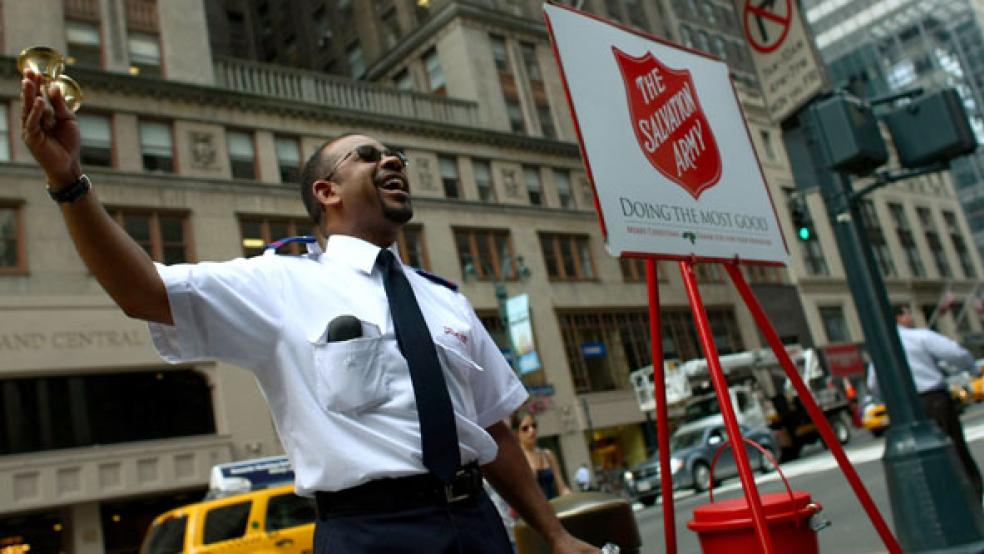The common thread running through the current crop of deficit reduction plans is the elimination of hundreds of special tax breaks. Both Paul Ryan and President Obama believe they can rake in billions in extra revenue, while reforming the tax code and making it less complicated. A target on nearly every deficit-reduction punch list is the charitable deduction — a break claimed by one-third of taxpayers who itemize. It will cost the fed $53.7 billion in fiscal 2011, and $315 billion over the next four years, according to the White House.
The effect of such a change on charitable and nonprofit organizations is more difficult to calculate, but it could be devastating. Alarm is building among fundraisers for the nation’s nearly 1.5 million nonprofits and charities, including schools, colleges and universities, hospitals, clinics, disease research organizations, museums, think tanks, and all the "save" nonprofits: Save the whales, the children, the landmarks, the parks, the nature preserves, and so forth.
These organizations rely heavily on donations from individuals, which made up 75 percent of the more than $300 billion in charitable contributions in 2009 by all sources, including corporations. High net-worth individuals, defined as those with household income greater than $200,000, account for as much as 53 percent of that total, according to GivingUSA. Yet nearly two out of three wealthy households would limit their charitable donations if there were no tax deductions, according to a 2010 Bank of America Merrill Lynch study.
“It’s inevitable that both state and federal budgets
are going be reduced and there’s going to be
increased pressure on charities to meet those needs.”
“There are those who make charitable contributions out of the goodness of their heart, but obviously there is a significant number of major givers who do so primarily for the tax benefit," said Greg Lam, a partner at Coplevitz & Canter, a law firm that represents nonprofits.
Any change in the charitable deduction would hurt Dana Farber Cancer Institute’s ability to do research, conduct clinical trials, and provide comprehensive care in its pediatrics division, according to Karen Bird, the center’s senior vice president of finance, since nearly 25 percent of the Institute’s revenue comes from gifts. “We might have to rethink some of the services we provide,” she said. Gift funding gets directed to the Institute’s pediatric division, for example. “For a kid with a bone marrow transplant or brain surgery, it’s not enough to just pay for the surgeon and the hospital,” she said. “They’re going to be out of school and need social support … there’s just a lot that insurance will never cover.”
If the $751 billion nonprofit sector takes a hit, it could ripple across the broader economy. Charities and nonprofits, which saw contributions drop about 20 percent during the financial crisis, employ about 10 percent of the nation’s workforce, according to Independent Sector, a lobbying coalition.
And since many nonprofits provide public services — from medical research to programs for the poor — some experts caution that a tax change could end up pushing services back onto cash-strapped states and the federal government. “It’s inevitable that both state and federal budgets are going be reduced and there’s going to be increased pressure on charities to meet those needs,” said Steve Taylor, Vice President and Counsel for Public Policy at United Way. “The government’s idea of cost savings could backfire,” adds Lam.
Carlye Teel, who has run a Seattle senior center for more than twenty years, worries that the local government wouldn’t be able to absorb their services if her organization’s donation base diminishes. Teel’s center serves more than 4,000 seniors a year, offering hot lunches, mental health services, blood pressure and diabetes checks, cancer screenings, financial planning help, and fitness services. About 72 percent of its budget comes from private contributions and grants — of which a sizeable chunk comes from relatively well-off individuals, according to Teel. “If our money dried up or got severely cut, I’m not sure who would or could step in to offer these seniors what we do,” Teel says. “Those folks would probably go underserved or not served at all — and it’s frightening to think of these seniors not having access to some of the services we provide that they count on.”
The Obama administration characterizes eliminating the deduction as closing a loophole for the rich. “While I agree with the goals of many of these deductions, like homeownership or charitable giving, we cannot ignore the fact that they provide millionaires an average tax break of $75,000,” Obama said in a speech in April. “I believe reform should … build on the Fiscal Commission’s model of reducing tax expenditures so there is enough savings to both lower rates and lower the deficit.”
The Fiscal Commission’s proposal would convert the gift deduction into a tax credit worth 12 percent of the amount donated, regardless of tax bracket — as long as the donation equals more than two percent of the taxpayers’ adjusted gross income. Obama’s 2012 budget caps the amount the highest two percent of earners could deduct from their tax bill at 28 percent of the dollars donated — compared to the current 35 percent cap. Paul Ryan’s “Path to Prosperity” budget blueprint would eliminate a host of tax deductions and, but it doesn’t specify which deductions and credits it will target.
'At the end of the day, for most of the people I work with,
the tax benefit is the icing on the cake.'
Any reduction to the tax incentive is likely to affect some charities more than others. “The plans we’ve seen would definitely affect the charities that high-income people give to more,” said Eric Toder, co-director of the Urban-Brookings Tax Policy Center. That means a change would have a relatively larger effect on the arts, higher education, and nonprofit hospitals and research institutions, he adds. It isn’t as likely to hurt religious organizations or charities for the poor, since those nonprofits get a lot of funding from the 70 percent of Americans who don’t itemize on their tax returns.
Bill Arning, Director of the Contemporary Arts Museum of Houston, says any of the proposed changes could threaten his ability to keep his doors open since, 83 percent of the museum’s income comes from individual charitable contributions. “We would expect to see contributed income reduced dramatically,” he says. “And as an institution that already operates on a lean budget, this would greatly impact how we are able to serve our community.”
But potential tax changes don’t necessarily mean all donations will dry up. Jim Lund, an Edina, Minn., financial advisor says he is confident that the bulk of his clients won’t change their giving plans. “At the end of the day, for most of the people I work with, the tax benefit is the icing on the cake, as opposed to the real driver for choosing to give money away,” said Lund who estimates 80 percent of his clients give to charity. “I feel like I know my clients long enough to know that they’ll continue their charitable planning just as they have in the past regardless of tax code changes.”
Some research supports Lund’s predictions — a 2009 study from the Indiana University Center on Philanthropy found that curtailing the tax deduction would have a relatively modest impact on giving. Liberal policy analysts and economists point to data that shows that despite the 1986 tax rate cut from 50 percent to 28 percent —so for every dollar donated, the taxpayer could deduct 32 cents less from the final tax bill — giving grew in the years that followed “It’s true that any proposal to reduce the deficit, including changing the charitable deduction, is going to have an impact somewhere,” says Seth Hanlon, Director of Fiscal Reform at The Center for American Progress. “But that doesn’t mean it will be detrimental.”
Related Links:
America’s Richest Tax Breaks (CNNMoney)
Charitable Deduction Limit: Bad for Arts Nonprofits? (NPR)
Three Cups of Tea Questions Remind Donors to Check Up on Charities (USAToday)





